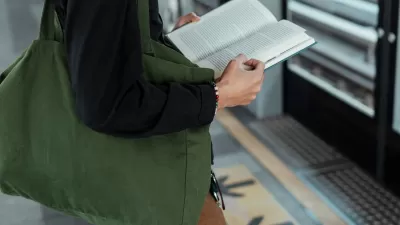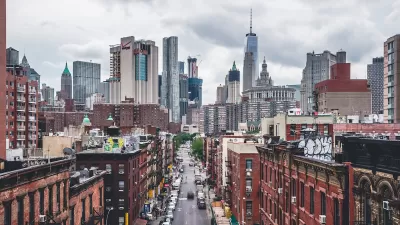The world is changing, and planning with it.

It might be cliché, at this point, to harp on post-pandemic shifts in society and governance. Three years in, the world has changed in some significant ways—and stayed staunchly the same in others. But the field of planning, like much of society, is in its own ways still reeling from the effects of the Covid-19 pandemic and adjusting to new realities that are reconfiguring the way we use space, how we move, and how we look at the world. We are also reckoning with the increasingly unpredictable impacts of a volatile climate, stronger hurricanes and more intense winter storms, sea level rise, more destructive fires, and longer heat waves.
From new transportation paradigms that center community-based planning to reassessments of historic planning and policy decisions that exclude minority groups to urgent calls to prepare for the impacts of climate change, planning and its related fields are undergoing a tectonic shift that turns a critical eye to the past with the goal of building a better future. The challenge for contemporary planners is to replace expanses of concrete with green spaces and living infrastructure resilient to weather events while limiting sprawl and building denser, more compact urban communities, repairing systems that perpetuate discrimination and inequity, and adapting urban systems to incorporate nature.
This year’s crop of books addresses land use, equity, road ecology, and climate change, and provides models for how planners can ensure their practice stays relevant to the urgency of today’s issues. The authors look to the future and propose strategies for redressing historical injustices, battling climate change, and making cities work better for everyone. In some cases, they offer intimate portrayals of places that inspire similar explorations of one’s own home city.
Please note that this list only includes books published between roughly November 2022 and October 2023. Books published in the last part of the year will be evaluated for next year’s list. Think we missed any outstanding books from this past year? Let us know!
This year’s list, in no particular order:
How Big Things Get Done: The Surprising Factors That Determine the Fate of Every Project, from Home Renovations to Space Exploration and Everything In Between
Bent Flybjerg and Dan Golden
Crown Currency
February 7, 2023, 304 pages
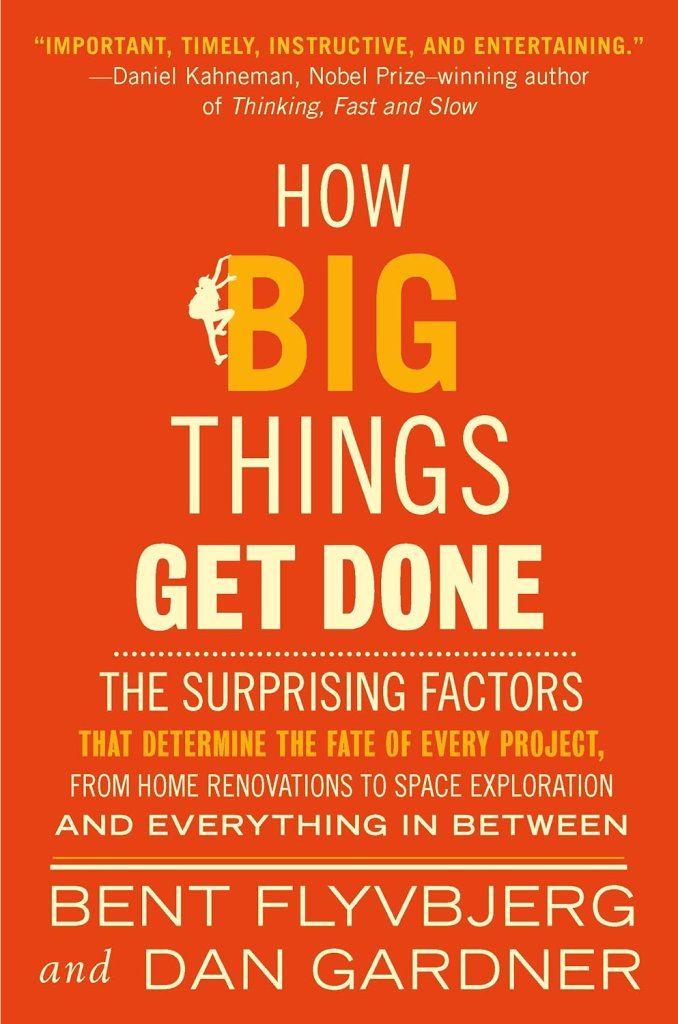 Often, being an urban planner means not having to worry about money. Plans are crafted in words, maps, and diagrams, and the niceties of building things--be they homes and businesses or civilization-defining infrastructure projects--are left to other people and entities. That's as it should be; no one can do everything. But, the fact remains that financing is what gives plans their meaning.
Often, being an urban planner means not having to worry about money. Plans are crafted in words, maps, and diagrams, and the niceties of building things--be they homes and businesses or civilization-defining infrastructure projects--are left to other people and entities. That's as it should be; no one can do everything. But, the fact remains that financing is what gives plans their meaning.
In many cases, as Bent Flybjerg and Dan Golden tell it in How Big Things Get Done, the atrocious cost overruns of pretty much every type of infrastructure project routinely complicate or undermine the goals of planning, whether planners know it or not. Flybjerg's research indicates that the worst offenders--nuclear storage, Olympic Games, dams, and information technology projects--routinely exceed their stated budgets by 100% or more. Projects friendly to urban planners, like bus rapid transit, rail, and buildings don’t fare much better.
He and Golden write with righteous indignation, sharing case study after case study to illustrate why projects cost so much and why. They also include a few examples of management and budgeting done right; clients--especially those in the public sector--can and should insist on efficiency from their contractors. For planners who stake their dreams on highways, transit lines, cultural institutions, and utilities to make their cities functional and pleasant, How Big Things Get Done is a sobering call to arms.
Portal: San Francisco's Ferry Building and the Reinvention of American Cities
John King
W. W. Norton & Company
November 7, 2023, 320 pages
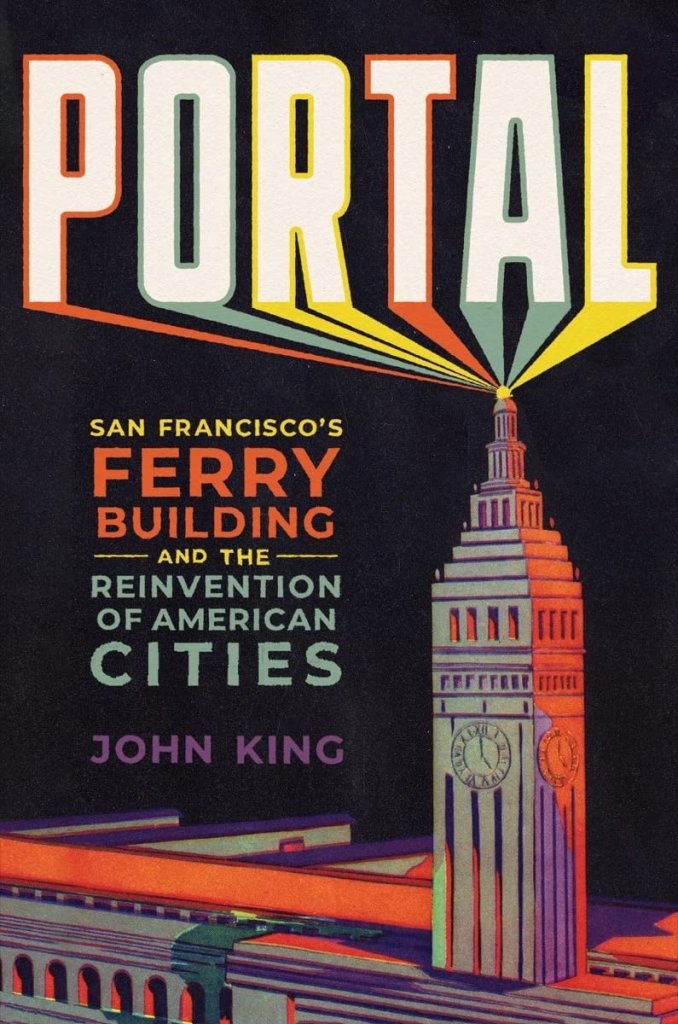
Portal, by the San Francisco Chronicle’s urban design critic John King, is at once a detailed description of a specific place and a universally applicable model for writing about cities. As King writes, “Every city has a landmark like this, a building through which one can read the larger history.”
The San Francisco Ferry Building serves as “a beacon and clock tower” for a city that has undergone dramatic changes in its relatively short history, a symbol of San Francisco’s power as a port city before its role was usurped by the city’s famous bridges. In its new incarnation, the building still serves as an icon in a reimagined landscape that now plays host to a farmers’ market and high-end boutiques, an anchor of a new type of transient visitor and residents alike.
“What makes the Ferry Building and similar landmarks into icons, however you define that nebulous word, is that they stay lodged in public consciousness, taking on new personas as the worlds around them change,” King writes. This is what makes King’s book valuable: the universality of a city’s need for icons, for anchors. Portal shows how an analysis of the rise, decline, and rebirth of one iconic building can reveal the character and history of a city.
In a similar vein, The Intimate City: Walking New York collects 20 walking tours that New York Times architecture critic Michael Kimmelman took in his home city, largely during the covid pandemic. Each is an detailed look at the history, design, and culture of the parts that make up the overwhelming whole of New York City. While Kimmelman's book and subject are sui generis, it is, at the same time, a model for how to experience a city and for a type of book that every city deserves.
Poverty, by America
Matthew Desmond
The Crown Publishing Group
March 21, 2023, 304 pages

Matthew Desmond, the Pulitzer Prize-winning author of Evicted, turns his incisive analysis to the broader question of poverty, highlighting specific examples of policies, laws, and habits that keep people in poverty and pile on to a mountain of existing barriers. In Poverty, by America, Desmond shows how housing, transportation, and labor laws and policies shape the livelihoods of low-income Americans.
Poverty isn’t uniquely American, but the level of poverty in one of the world’s wealthiest nations is a uniquely American phenomenon that is by no means inevitable or irreversible. Desmond calls for a recognition that many upper-middle-class Americans are complicit in these systems and can make choices—such as supporting exclusionary zoning—that perpetuate inequity.
Acknowledging the systemic causes of poverty and inequality, Desmond also draws attention to the perfectly rational decisions made by individual people that perpetuate difficult economic conditions for others. Desmond charges “the secure, the insured, the housed, the college educated, the protected, the lucky” with some of the responsibility for inadvertently upholding a system of oppression and generational poverty and calls for policies that empower workers, mandate fair wages, and give people agency over where they live and work. By the last chapters, Poverty, by America reads like a guidebook full of sensible solutions—some of which are already making an impact in communities around the country.
The problem with pavement
The consequences of paving over vast swaths of land with hard, impermeable surfaces is becoming glaringly apparent in more ways than one. From the rise in housing costs and sprawl induced by devoting excessive amounts of land to parking to the ways that flora and fauna adapt to urban environments, the books in this section reassess the relationships between urban spaces, urban life, and the environment. Roads and transportation infrastructure, critical to human mobility, has wreaked havoc on the migration patters and populations of countless other animal species and contributed to unsustainable development patterns.
Paved Paradise: How Parking Explains the World
Henry Grabar
Penguin Random House
May 9, 2023, 368 pages
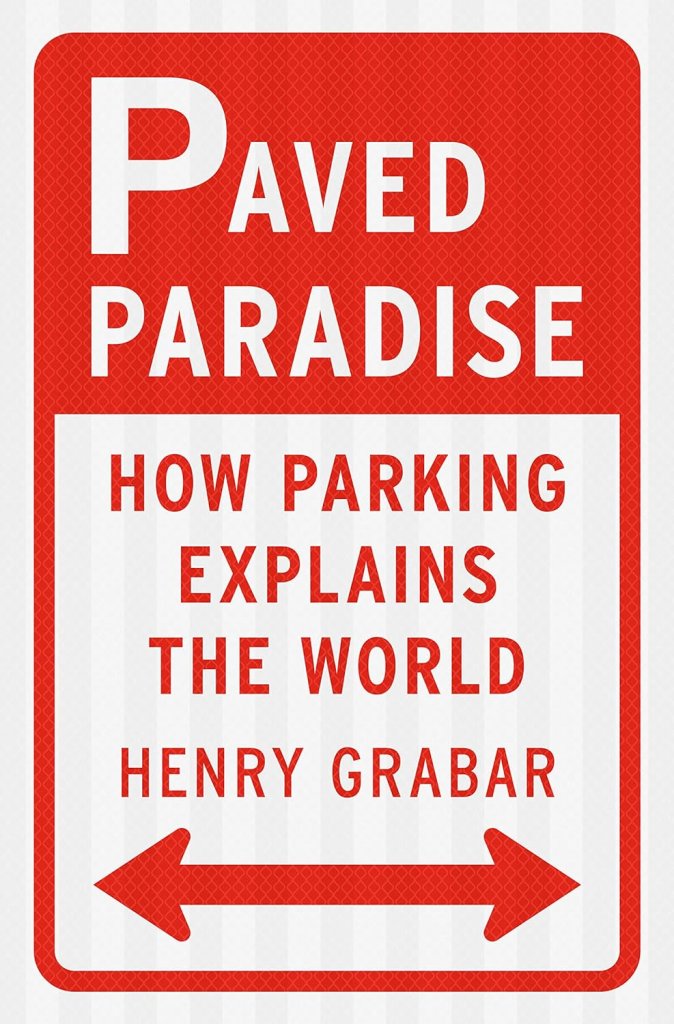
Every aficionado of UCLA Professor Emeritus and parking sage Donald Shoup has a favorite anecdote to illustrate the professor's arcane, if poignant, economic analyses that explain why parking is underpriced, overabundant, and aesthetically abhorrent. Now, Harry Grabar has saved them the trouble. Combining the best of Shoup's scholarly analysis with a journalistic approach to anecdote and explanation, Paved Paradise argues loudly and clearly for the cause of parking reform.
Grabar covers the usual arguments, like absurd parking minimums that lead to malls' asphalt hoop skirts and restaurants that have more stalls than tables. But, he goes deeper, revealing ice cream truck wars in New York City, various misdeeds among commercial parking operators, and the absurd amount of urban landscape dedicated to unmoving vehicles. He rightfully embarrasses the city of Chicago for selling off its parking meters to a hedge fund, and he laments the ways parking requirements have made cities less hospitable and uglier than they would otherwise be. If Shoup started the world's most benevolent cult, it's Grabar who might convince the masses that there really is no such thing as "free" parking.
Crossings: How Road Ecology is Shaping the Future of our Planet
Ben Goldfarb
W. W. Norton & Company
September 12, 2023, 384 pages

After decades of ignoring the impacts of road building and transportation infrastructure on animals, migration, and ecosystems, policymakers are recognizing the ways in which our car-centric planning has impacted communities human, animal, and plant alike. In Crossings, Ben Goldfarb outlines how human transportation infrastructure disrupts migration patterns and threatens species and ecosystems—and what we can do about it. Now, cities as famously car-oriented as Los Angeles are finally heeding the call and investing significant resources into reversing the harmful impacts of freeways and roads on wildlife with wildlife bridges and other infrastructure aimed at helping animals retain their mobility across and around fast-moving roadways and preserve ancient migration patterns.
Crossings shows how human-centric planning has stunted our ability to critically think about the rest of the natural world and our role in it. In a similar vein, Paul F. Donald’s Traffication: How Cars Destroy Nature & What We Can Do About It provides a U.K.-based analysis of road ecology, delving into how road design and noise impact animal populations and including example interventions from around the world.
Urban Jungle: The History and Future of Nature in the City
Ben Wilson
Doubleday
March 7, 2023, 304 pages

Cities are ecologies unto themselves, and their ecologies are nearly as complex as are their built environments or their societies. That's the thesis of Urban Jungle: The History and Future of Nature in the City, by Ben Wilson. It would be easy enough to explain how cities have destroyed nature, but that's not Wilson's aim. He explains all the ways that flora and fauna thrive in, and influence, the cities that have grown up around them or, in the case of nonnative species, that have attracted them. He discusses parks, waterways, the urban fringe, urban agriculture, and the symbiosis between natural resources and urban needs.
In lesser hands, Urban Jungle would be a disaster. Or, it a at least, far less compelling than it is. That's because Wilson manages to leap thousands of miles from one sentence to another, connecting disparate cities like London, New York, and Mexico through common traits in the span of just a few pages. And he's not afraid to travel beyond the boundaries of ecology, quoting literary figures and referring to historical events at unexpected turns (Charles Dickens is a frequent contributor to Wilson's discourse; Chaucer makes an appearance too). Somehow, it all works, and anyone who wants to understand the life of cities will come away learning that—and much more.
The End of Eden: Wild Nature in the Age of Climate Breakdown looks at climate change from another perspective: not how it will change human civilization but rather how it will change Mother Nature herself. Animals, plants, and entire ecosystems will change, and even die off, because of the carbon that the industrialized world is emitting. They are largely unseen by urban dwellers, but author Adam Weltz reminds us of how much they will be missed when they are gone.
The night sky may be more closely associated with deserted hinterlands than with cities—and that's the point of The Darkness Manifesto: On Light Pollution, Night Ecology, and the Ancient Rhythms that Sustain Life. Gorgeously written, Johan Eklöf's slim volume asks us to rediscover the wonder of the night sky and consider how cities might be dimmed for the benefit of humans and creatures alike.
Planning is not neutral
In many ways, the pandemic dramatically laid bare the inequities and vulnerabilities built into many of our institutions and systems. Planners are increasingly recognizing that planning—whether it’s housing policy, transportation planning, economic development, or parks design—is not neutral, and that decisions can have vastly different impact on different populations. As the harmful impacts of the interstate highway system, midcentury urban renewal, and top-down planning become more recognized by researchers and transportation officials, the challenge becomes changing entrenched policy and addressing the impacts of monumental infrastructure projects with both short- and long-term interventions.
Roadways for People: Rethinking Transportation Planning and Engineering
Lynn Peterson and Elizabeth Doerr
Island Press
December 6, 2022, 264 pages
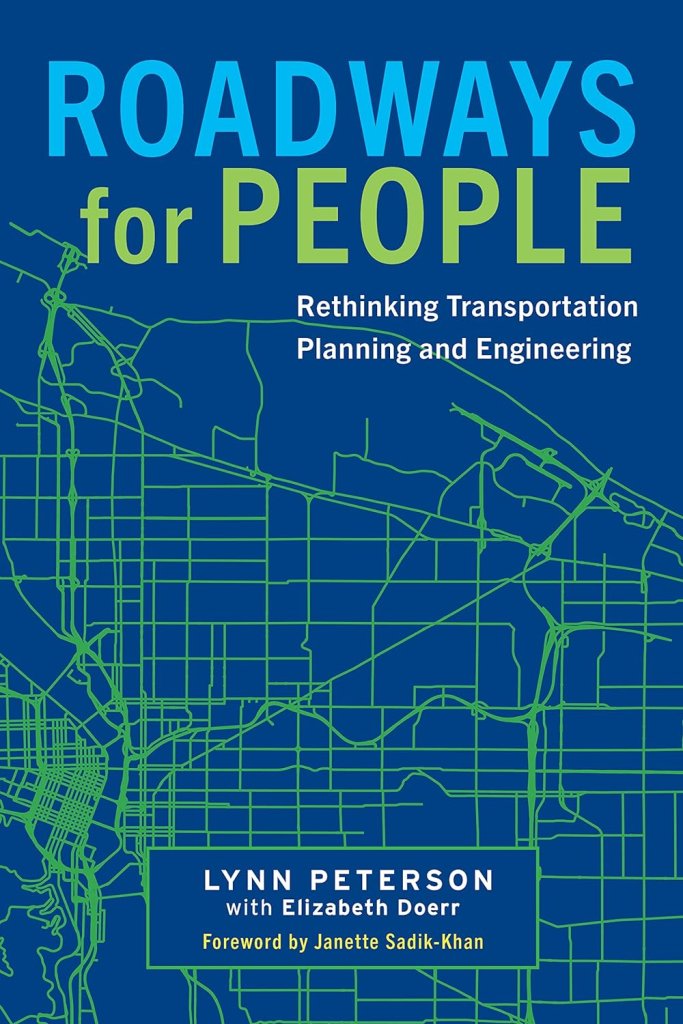
In Roadways for People, Peterson and Doerr use an example from Portland, Oregon to provide a manual for reframing the transportation planning process to create a more community-centered and collaborative process. For Peterson and Doerr, “process is everything.” Rather than focusing on traditional metrics like vehicle throughput, speed, and budget, the authors expand their considerations to include more subjective measures of quality projects: consideration for the land, the local community, and quality of life. The book develops a racial equity approach deemed necessary because Black and Brown communities are often disproportionately impacted by poor infrastructure, inadequate mobility, and aggressive traffic enforcement. A new paradigm requires an acknowledgment of past injustices and a commitment to redressing them, reorienting professional ethics to center the empowerment of local residents, and building trust.
Other authors similarly highlight the urgency of understanding how transportation planning has never been neutral, and how decisions often considered benign or beneficial harmed the communities closest to them. In Inclusive Transportation: A Manifesto for Repairing Divided Communities, Veronica O. Davis shows how transportation planners can turn a more comprehensive lens to the process that takes into account a variety of road users and reconnects communities (to use a term now coopted by the federal government) divided and stunted by freeway projects.
New climate realities
With climate-related disasters becoming more frequent, creating sustainable, resilient systems is an increasingly urgent concern touching everything from infrastructure to housing to migration. As governments begin to establish resiliency plans and climate offices, these books offer a glimpse into the crisis.
Smaller Cities in a Shrinking World: Learning to Thrive Without Growth
Alan Mallach
Island Press
June 13, 2023, 336 pages
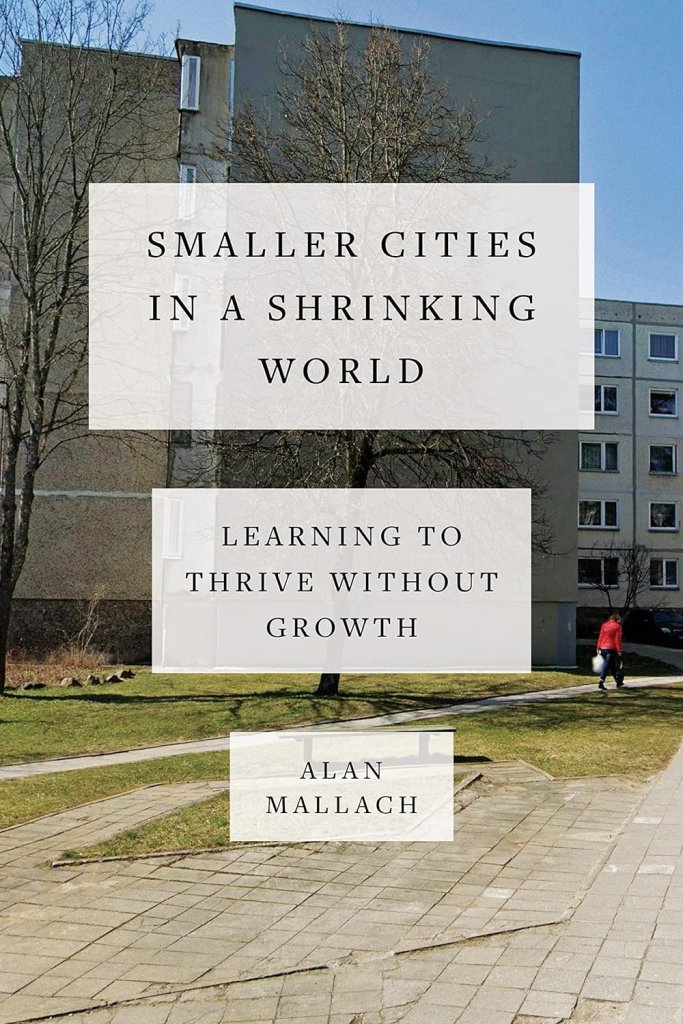
For at least a half-generation, demographers have been quietly wringing their hands over the prospect of population decline. Sure, it's been happening in Poland, Japan, and Sardinia, but the rest of the world has still been procreating to their hearts' content, right? Not exactly.
Global demographic patterns may not shift quickly, but they do shift surely. Alan Mallach reports that a great many countries are on the precipice of uncharted territory. China is one of them, thanks to the excessive success of the One-Child Policy, and the United States is too. Smaller Cities in a Shrinking World is one of the first, if not the first, major book to tell urban planners that the party might be over—and that the next generation of urban plans might have to figure out how to make cities smaller rather than bigger, as they have done literally since the arrival of the Mayflower.
Mallach is singularly well suited to the task. He is, arguably, the country's foremost scholar on “legacy” (i.e. Rust Belt) cities and has cataloged the economically motivated contractions of cities like Detroit and Cleveland. The next great declines, though, will have more to do with birth rates than factory closures. Mallach warns planners to account for demolition of vacant properties, care for the elderly, and shrunken city economies, among many other effects -- and he offers no easy answers for how the political will will be mustered, how the plans will be devised, or who is going to pay for any of it.
“Will” is a strong word, but Jeff Goodell makes a strong case. The Heat Will Kill You First catalogs myriad ways in which rising temperatures—caused by anthropogenic climate change—will ruin crop yields, melt glaciers, and push—and exceed—the limits of what human biology can withstand. He highlights the urban furnaces of Phoenix, Lahore, Chennai, and (sometimes) Paris. He argues, convincingly and chillingly, that too few places are impervious to the coming (permanent) heat wave.
The Great Displacement: Climate Change and the Next American Migration
Jake Biddle
Simon & Schuster
February 21, 2023, 368 pages
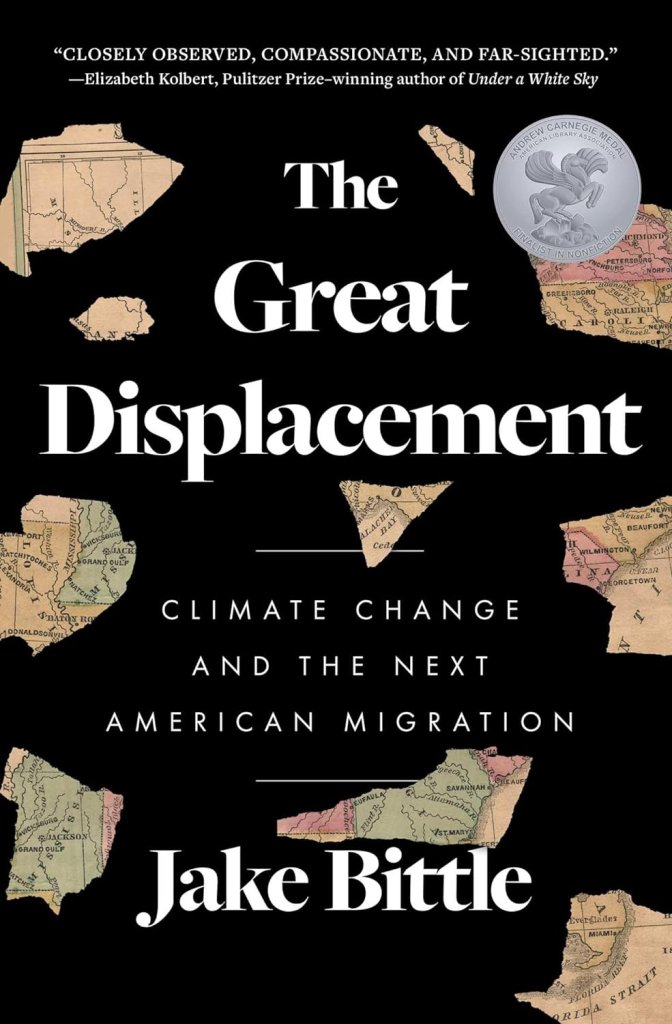
Among the many consequences of climate change, the potentially massive movement of human beings is one of the least discussed. For cities that become uninhabitable due to heat or flood, migration will render them ghost towns. For cities fortunate enough to remain habitable—or, at least, more habitable than others—the crush of climate refugees may strain every thread in the fabric of society. In The Great Displacement, Jake Biddle chronicles migrations that have already begun and anticipates far greater ones to come.
One of the lesser-known titans of narrative nonfiction, John Vaillant grippingly recounts the tragedy of Fort McMurray, Alberta, which was consumed by wildfires in 2016. Fire Weather: A True Story from a Hotter World tells a “tragedy” in the most classical sense of the world: the city is a hub of oil production, thus creating the carbon emissions that led to its own demise. Though localized, the story of Fort McMurray will surely not be the last of its kind.
Plan(et) B
A bizarre twist on the migration options is the subject of not one, but two books on off-Earth colonization--particularly that of Mars. Despite boosterism by certain billionaires and techno-utopianists, both A City on Mars: Can We Settle Space, Should We Settle Space, and Have We Really Thought This Through?, by Kelly Weinersmith and Zach Weinersmith, and The First City on Mars: An Urban Planner’s Guide to Settling the Red Planet, by Justin Hollander, argue that urban planning on Mars is a clever thought experiment at best and, were anyone to attempt implementation, a certain recipe for a cold, lonely, desiccated, irradiated death. Clever as they are, neither book goes far enough to explain why any amount of money and brainpower spent fantasizing about Mars decreases our chances of rehabilitating the miraculous planet we already inhabit.

Alabama: Trump Terminates Settlements for Black Communities Harmed By Raw Sewage
Trump deemed the landmark civil rights agreement “illegal DEI and environmental justice policy.”

Planetizen Federal Action Tracker
A weekly monitor of how Trump’s orders and actions are impacting planners and planning in America.

The 120 Year Old Tiny Home Villages That Sheltered San Francisco’s Earthquake Refugees
More than a century ago, San Francisco mobilized to house thousands of residents displaced by the 1906 earthquake. Could their strategy offer a model for the present?

San Francisco Opens Park on Former Great Highway
The Sunset Dunes park’s grand opening attracted both fans and detractors.

Oregon Legislature to Consider Transit Funding Laws
One proposal would increase the state’s payroll tax by .08% to fund transit agencies and expand service.

Housing Vouchers as a Key Piece of Houston’s Housing Strategy
The Houston Housing Authority supports 19,000 households through the housing voucher program.
Urban Design for Planners 1: Software Tools
This six-course series explores essential urban design concepts using open source software and equips planners with the tools they need to participate fully in the urban design process.
Planning for Universal Design
Learn the tools for implementing Universal Design in planning regulations.
Clanton & Associates, Inc.
Jessamine County Fiscal Court
Institute for Housing and Urban Development Studies (IHS)
City of Grandview
Harvard GSD Executive Education
Toledo-Lucas County Plan Commissions
Salt Lake City
NYU Wagner Graduate School of Public Service


























